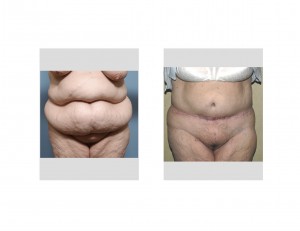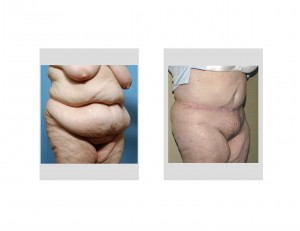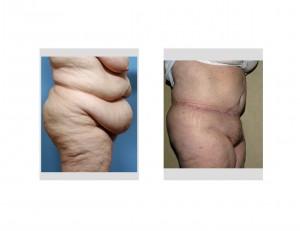Background: Tummy tucks are done for a wide variety of abdominal wall deformities. Whether it is a small lower pooch from pregnancies or a large overhanging pannus from a lifetime of weight gain (and some weight loss), tummy tucks are done in an almost customized fashion for each patient. The location and extent of the abdominal incisions must be casefully planned and executed for each type of abdominal wall problem.
Abdominal wall deformities can often be expressed in the number of rolls present. Most patients have just one roll present which is often spread out over the whole lower abdomen. When multiple abdominal rolls are present they often cascade or pile up on each other like a set of mountains of which some of it falls over the waistline.
Case Study: This 52 year-old woman had a large abdomen that she wanted to get rid of. It was hard to find clothes to fit and it was uncomfortable to carry it around. She had two large skin and fat rolls that hung over her waistline and gave her back pain as well. One interesting and potentially confounding issue was a very long and old gall bladder removal scar from over thirty years ago. This had potential compromise of the vascularity of the upper abdominal flap from the tummy tuck…although there was no way to avoid this potential issue short of not doing the procedure.



Case Highlights:
1) Tummy tuck surgery is very effective at eliminating the ‘double roll’ abdominal wall deformity.
2) Removal of the abdominal double roll requires little undermining of the upper abdominal skin flap and thus is safe even when large oblique abdominal surgical scars are present.
3) The tightest part of the double roll tummy tuck is along the waistline, often leaving a bulge above and below the scar line.
Dr. Barry Eppley
Indianapolis, Indiana


